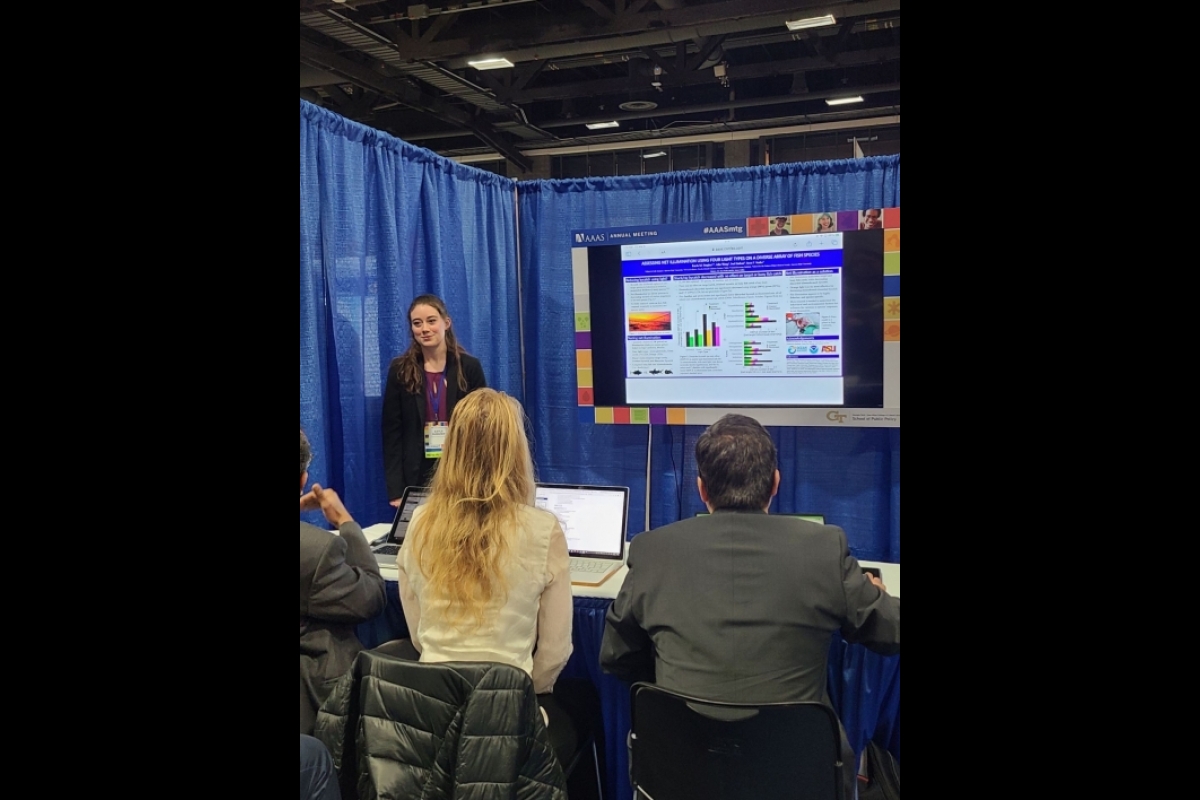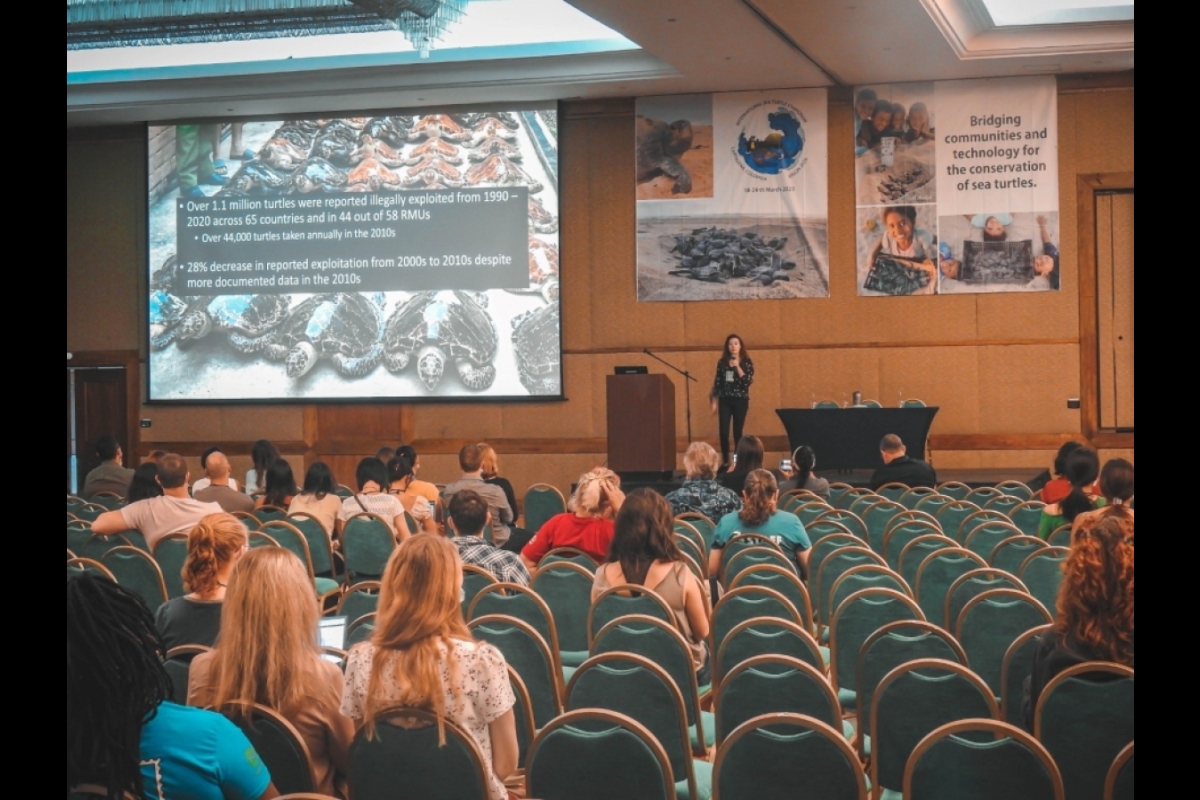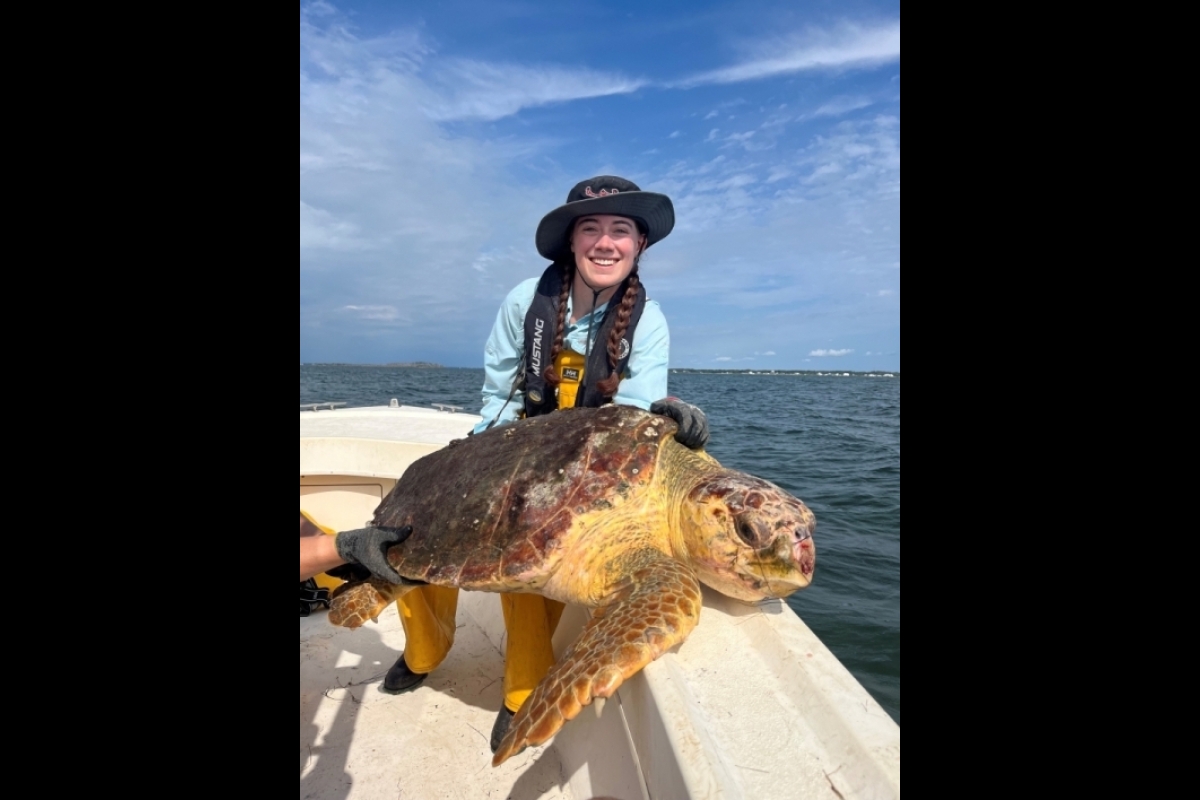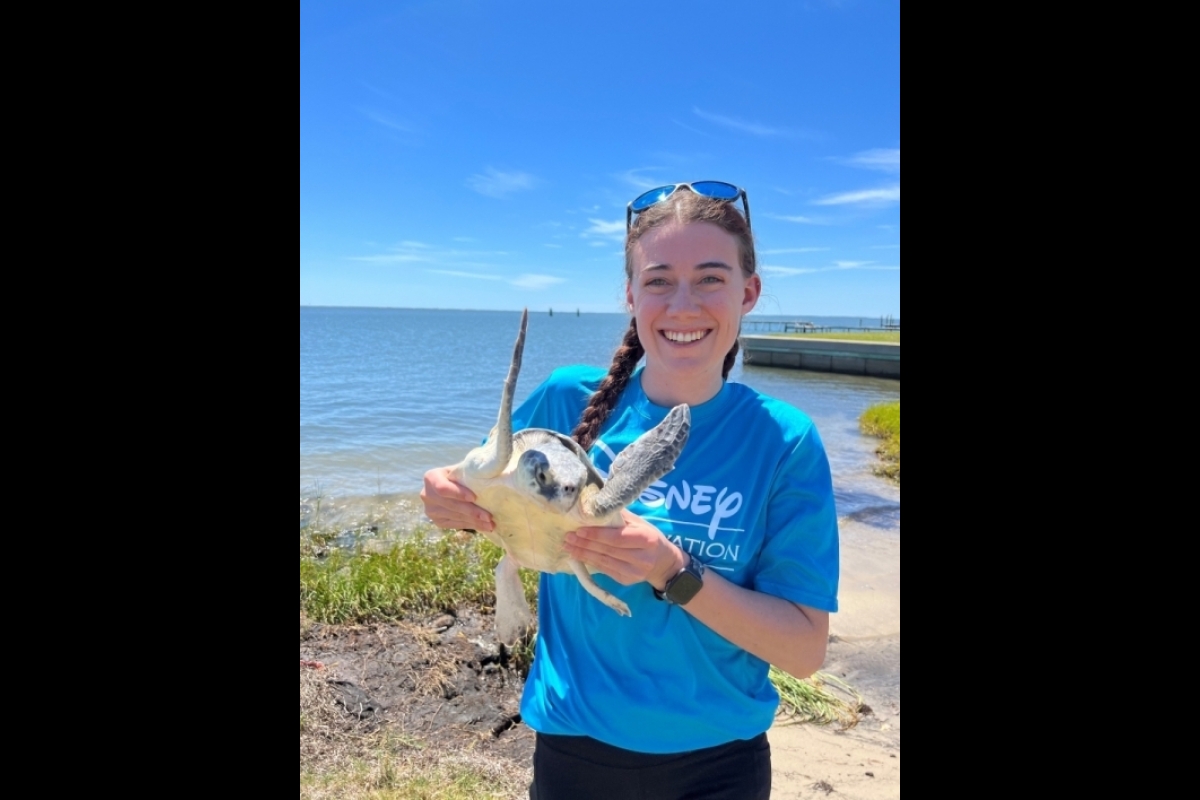First sea turtle exploitation assessment wins ASU graduate award at international conference
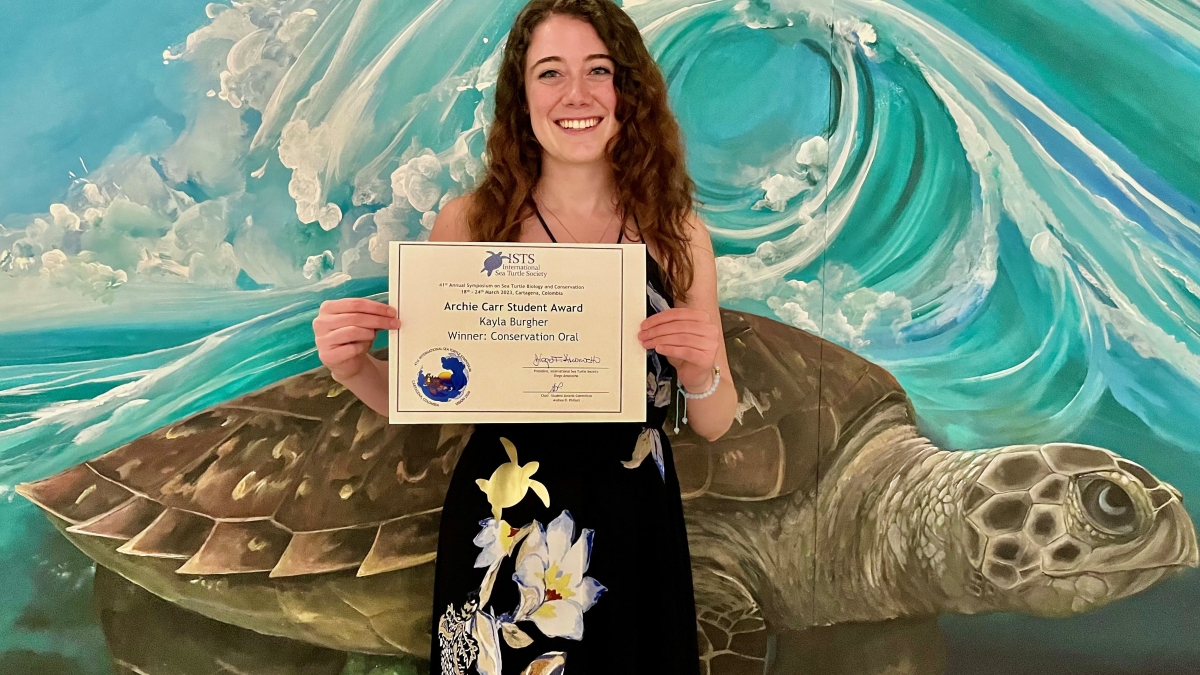
Kayla Burgher won the Archie Carr Student Award for her presentation "Global patterns of illegal marine turtle exploitation" at the 41st International Sea Turtle Symposium in Cartagena, Colombia. Photo courtesy Kayla Burgher
Arizona State University PhD candidate Kayla Burgher recently won two prestigious awards for her research at international conferences.
Burgher was awarded first place in the American Association for the Advancement of Science (AAAS) competition for best graduate student poster in environment and ecology.
She presented her research poster, titled "Assessing net illumination using four light types on a diverse array of fish species," at the AAAS 2023 annual meeting held in Washington, D.C.
For this project, she synthesized seven years' worth of data from paired net illumination trials in Mexico. She found that putting LED lights on fishing nets significantly reduced the bycatch, or accidental capture, of sharks and rays with no effects on target fish catch.
Burgher was also awarded the Archie Carr Student Award for best conservation oral presentation at the 41st International Sea Turtle Symposium (ISTS). The symposium was held in Cartagena, Colombia.
Burgher delivered a research presentation, "Global patterns of illegal marine turtle exploitation," which detailed findings from a lengthy project synthesizing data from an array of sources to evaluate illegal sea turtle exploitation at the global scale from 1990 through 2020.
She found that, during three decades, over 1.1 million turtles were exploited in 65 countries and in 44 out of 58 of the world’s major sea turtle populations.
"I have had the pleasure of working with Kayla since she was an undergraduate student here at ASU. Her PhD research on sea turtles and fisheries bycatch is innovative and combines field and laboratory work in both the Pacific and Atlantic Ocean basins, where she is collaborating with NOAA (National Oceanic and Atmospheric Administration) scientists and local fishers to develop new solutions to reduce sea turtle bycatch while maintaining fisheries production,” said Jesse Senko, assistant research professor.
“To work with such diverse stakeholders in multiple ocean basins as a PhD student is exceedingly rare and epitomizes how Kayla represents the next generation of ocean conservation leaders,” he said.
Burgher is pursuing her PhD in environmental life sciences from the School of Life Sciences. We talked with her about the recent conference awards, her time at ASU and her passion for sea turtles and marine conservation.
Question: Could you tell us a little bit about your journey before you came to ASU? What was your “aha” moment when you realized you wanted to study the field you majored in?
Answer: While I’ve always had a fascination with the ocean and science, the moment I truly knew that I wanted to devote my life to marine conservation came while on a study-abroad program in my sophomore year of undergrad. I had traveled to Mexico to take part in a study abroad called “Sea Turtles, Sharks, and Fisheries of Baja California: Emerging Topics in Marine Conservation." There, I assisted with a sea turtle monitoring program where I had my first experience up close and personal with a sea turtle.
One evening, I sat anxiously in a small boat as the captain, a local fisher, piloted us towards the turtle nets we had set earlier that day. Once we arrived, we scoured the nets, hoping to see at least one turtle. We had just about given up hope, but as we neared the end of the net when we heard a splash. “¡Tortuga!” the captain shouted. We began the process of hauling the 350-pound turtle onto the boat. After almost falling overboard and getting splashed quite a bit more than I had anticipated, a beautiful green turtle laid next to me. My anxiety melted away as I gazed into the prehistoric eyes of a turtle taking a massive cavernous breath; my breath was taken and my soul shook.
At that moment I knew I needed to dedicate my career to saving these majestic, prehistoric creatures, along with the ocean that they call home.
Q: Could you tell us more about your research assessing net illumination and your experience presenting at the AAAS meeting?
A: AAAS was the first in-person conference I had the opportunity to attend as a graduate student, so it was a great experience to help prepare me for ISTS later that month. I really enjoyed exploring the wide range of topics and learning new perspectives from scientists in diverse fields. At the conference, I was very intrigued by the heavy focus on scientific communication. Since my field relies so heavily on effective communication for positive outcomes, it was really eye-opening to hear about which communication techniques were effective and which were not.
My presentation was on a project I’ve been working on for a few years now. For this project, I am assessing how attaching four types of lights to fishing nets affects the catch of fish, sharks and rays. Prior research has shown that net illumination is successful at reducing the bycatch of sea turtles and other marine megafauna. However, my project is the first to investigate how fish are affected, giving researchers and conservation managers a more complete picture of how net illumination would impact catch rates in specific fisheries. I found that elasmobranch (sharks, rays and skates) bycatch was reduced using net illumination, with orange light being the most effective. These are exciting results given that elasmobranchs are a group of conservation concern that are very often caught as bycatch in small-scale fisheries. On the other hand, bony fish catch and target catch was not impacted by net illumination, suggesting that fishers’ livelihoods would not be negatively affected by net illumination.
Q: Could you describe your research assessing global patterns of illegal marine turtle exploitation, and your experience presenting at the International Sea Turtle Symposium?
A: Attending ISTS this year was a culmination of many years of hard work and waiting. I began working on the project exploring global illegal marine turtle exploitation during my undergraduate years and had planned to present on the subject at ISTS in 2020. However, the symposium was cancelled due to COVID. Fast-forward a few years, and I have finally finished the project on illegal sea turtle exploitation and have since gotten the work published in Global Change Biology. Additionally, I finally got the chance to present this work at this year’s ISTS.
Presenting such an impactful global study really got my name out into the sea turtle community. After my presentation, several researchers I look up to came up to congratulate me and talk to me more about my work. My presentation also got the attention of Larry Crowder, a professor at Stanford who I’ve been wanting to work with for years. I now have plans to go visit him in the fall to discuss potential collaborations and projects. Ultimately, this presentation has allowed me to get my foot in the door of my field and has opened up many additional opportunities for projects and potential postdoc positions.
As for the project itself, I collated data from peer-reviewed literature, grey reports, media articles and expert surveys to assess global illegal sea turtle exploitation from 1990 to 2020. I found over 1.1 million turtles were exploited across the three decades in 65 countries. The majority of turtles exploited were either green or hawksbill turtles.
Our assessment suggests that illegal exploitation appears to have declined over the past decade and, with some exceptions, is primarily occurring in large, stable and genetically diverse marine turtle populations. While the global legal take of sea turtles has been quantified, this is the first assessment of illegal global exploitation.
Q: What’s something you learned while at ASU — in the classroom or otherwise — that surprised you or changed your perspective? Or a professor that taught you an important lesson while at ASU?
A: While at ASU, my perspective about how research is used to create real-world change has shifted. Before beginning my PhD, I had the assumption that any published research could easily be viewed and utilized by decision-makers, with the scientists staying in their corner and decision-makers in theirs. However, after being involved in several conservation projects, I now see how important it is to establish effective networks of communication between researchers, decision-makers and those who the decisions will affect. Transdisciplinary collaboration has the potential to make the translation of research into outcomes more efficient, effective and just.
Q: What’s the best piece of advice you’d give to those still in school, particularly those in STEM considering a graduate degree?
A: Say "yes" to any opportunity that interests you, whether that’s a research experience, a chance to meet with scientists whose work interests you or even a volunteer position within your field of interest. You never know who you are going to meet that will be influential for your career. Many of the opportunities I’ve had simply came from being present and running into the right people.
Q: What is your favorite spot on campus, whether for studying, meeting friends or just thinking about life?
A: I love spending time in the social sciences building surrounded by all the plants. It’s a great space for me to decompress after working for too long in my office or chat with fellow grad students about life that also provides reprieve from the Arizona heat.
Q: What are your plans after you complete your degree in a few years?
A: After graduation, I would like to continue my research in fisheries management either as a professor or working at the National Oceanic and Atmospheric Administration. However, I’m keeping my options open, as one thing I’ve learned during my PhD is that you never know what opportunities will come your way.
More Science and technology

ASU-led space telescope is ready to fly
The Star Planet Activity Research CubeSat, or SPARCS, a small space telescope that will monitor the flares and sunspot activity…

ASU at the heart of the state's revitalized microelectronics industry
A stronger local economy, more reliable technology, and a future where our computers and devices do the impossible: that’s the…

Breakthrough copper alloy achieves unprecedented high-temperature performance
A team of researchers from Arizona State University, the U.S. Army Research Laboratory, Lehigh University and Louisiana State…


